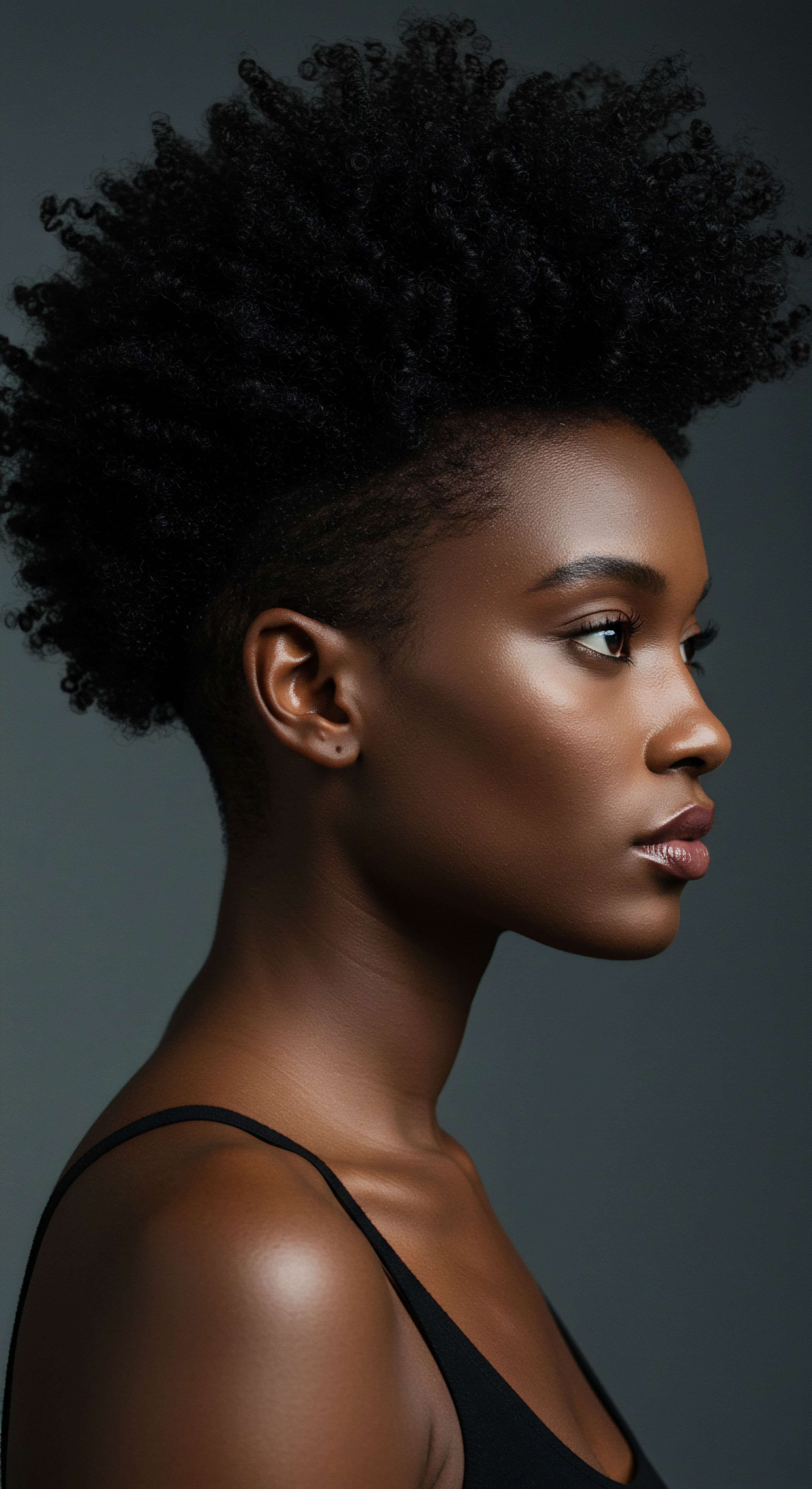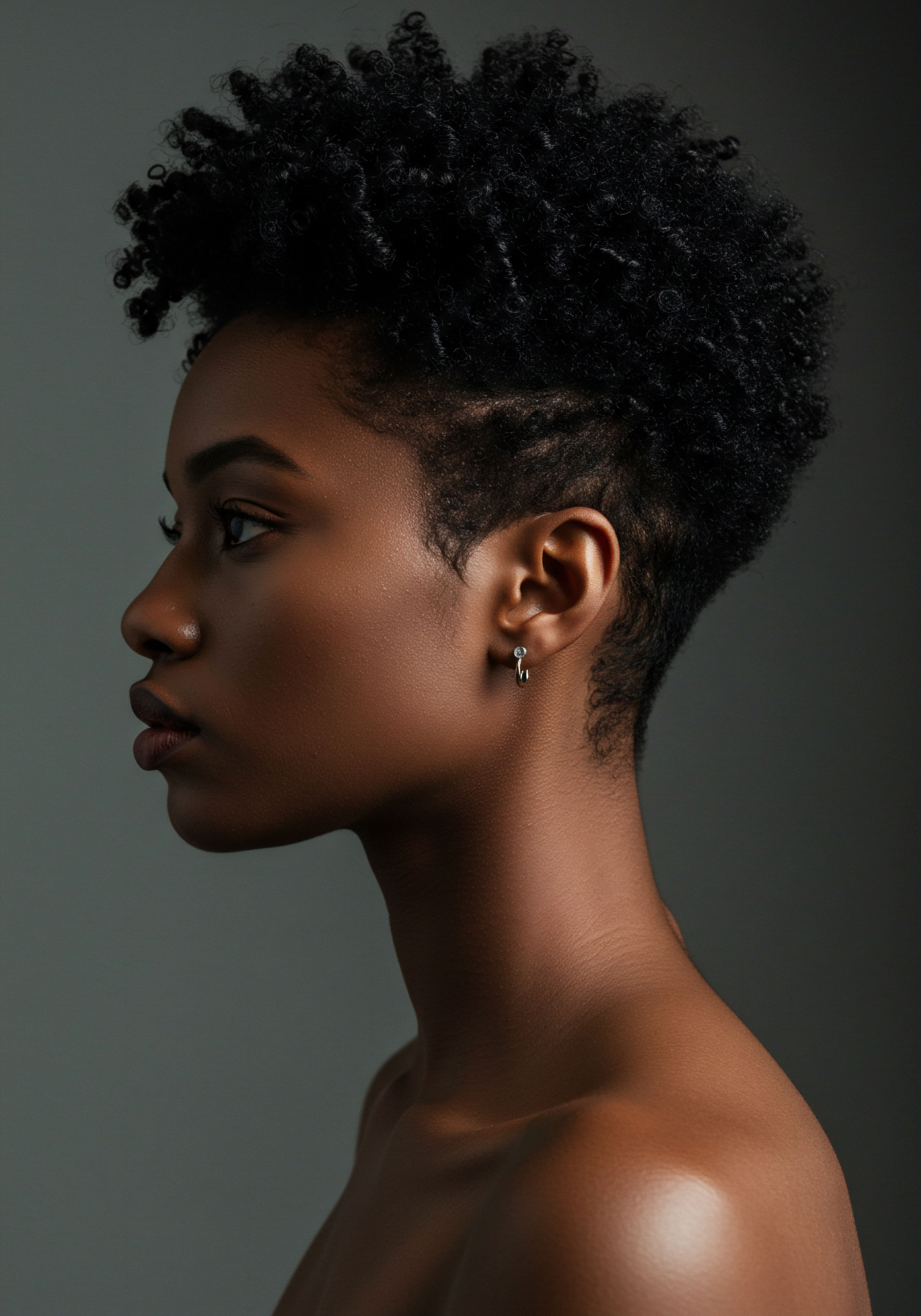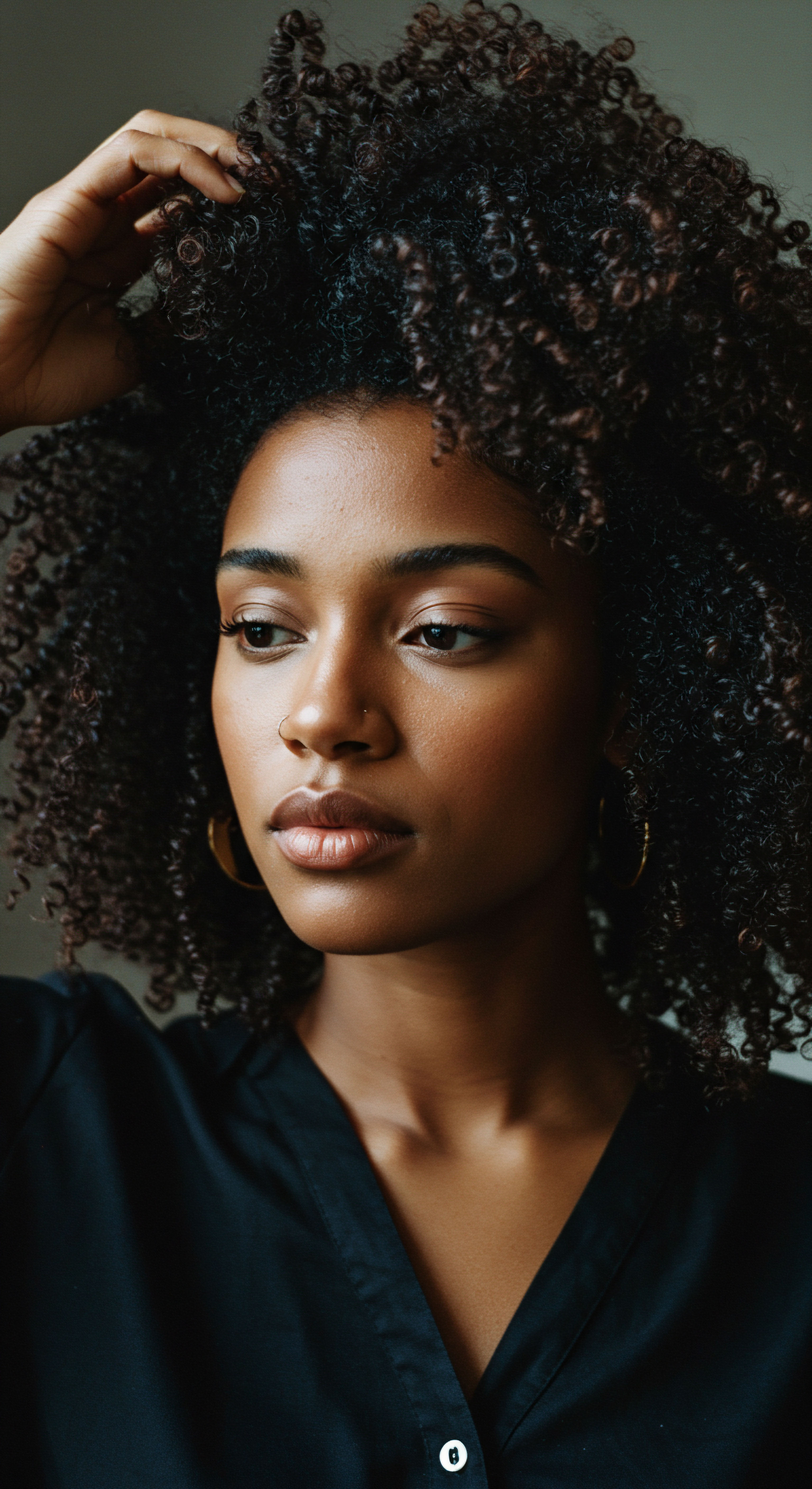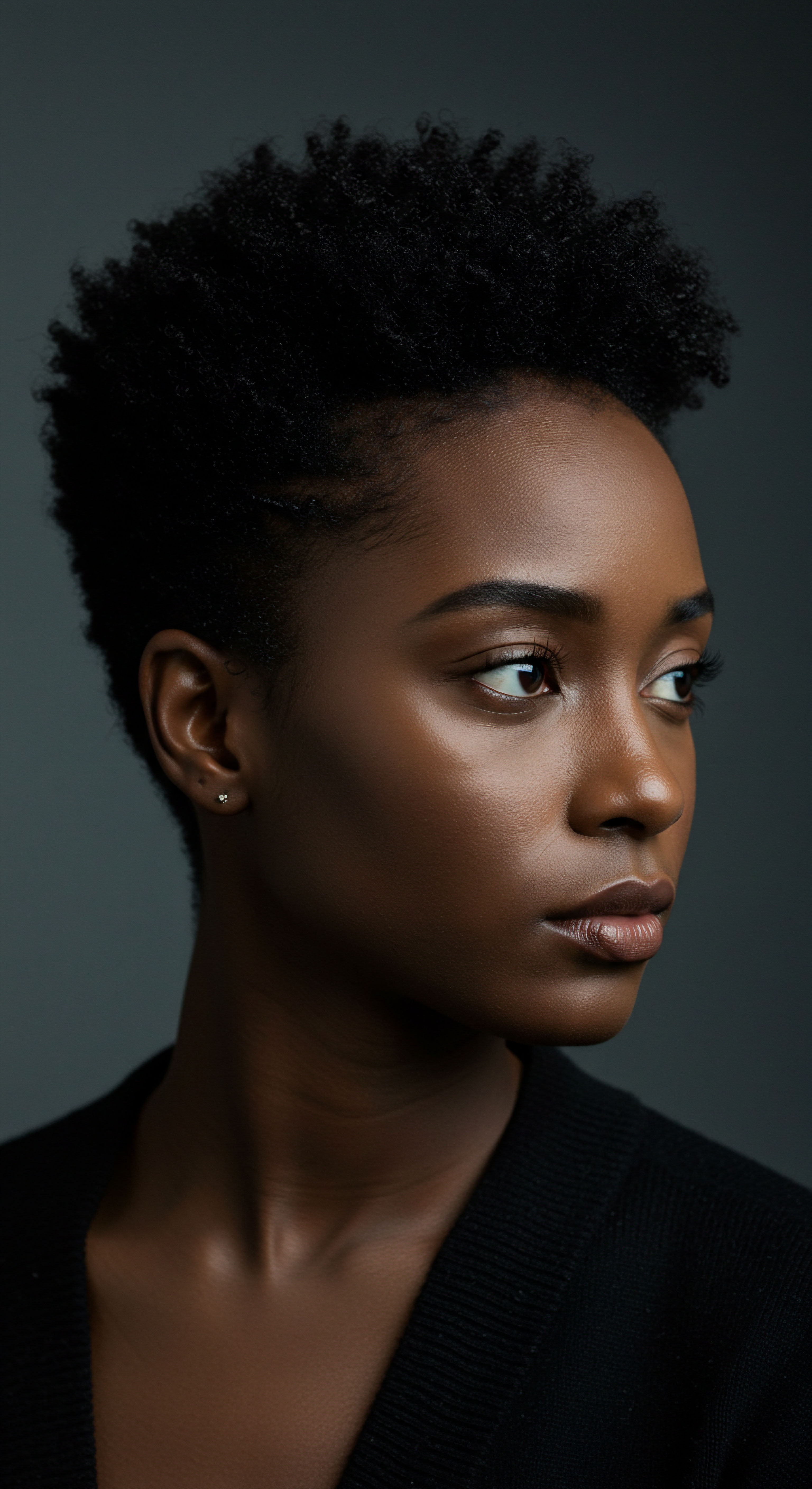
Roots
The quiet rustle of fabric, the gentle shaping of a scarf, the subtle nod of a headwrap — these seemingly simple acts carry histories as deep and complex as the earth itself. For Black women, covering their hair has never been a singular statement or a fleeting trend. Instead, it represents a rich tapestry woven from survival, cultural pride, spiritual devotion, and personal declaration.
To truly comprehend this profound practice, one must reach back through centuries, listening to the echoes of ancestral wisdom and the whispers of resilience carried on the wind. This exploration begins at the very origins, delving into the foundational reasons that planted the seeds of this enduring tradition.

What Were the Earliest Cultural Foundations for Hair Covering?
Across various African societies, long before the transatlantic slave trade reshaped destinies, hair held immense social and spiritual weight. It served as a powerful communicator, a visual language signaling a person’s identity, marital status, age, wealth, and even their religious affiliations. Hairstyles were not merely aesthetic choices; they were intricate expressions of communal belonging and individual standing. In some cultures, the head was considered the most elevated part of the body, a spiritual connection point to the divine, making its adornment or covering a sacred act.
For example, the Yoruba people of Nigeria, known for their elaborate headwraps called ‘geles,’ used specific styles and fabrics to denote a woman’s marital status or wealth. The artistry involved in these head coverings was a testament to cultural richness and personal skill. Similarly, in other West African communities, the way a woman wore her headwrap could signify her family ties, regional origin, or social position. These coverings also served practical purposes, offering protection from the elements, like the intense Sahara sun, or from dust and grime during daily activities.
Hair coverings in traditional African societies were not merely decorative; they communicated a wealth of personal and communal information, from social standing to spiritual connections.
The materials used often held significance too. While indigenous fabrics were prominent, the arrival of European and Asian textiles through trade routes led to their incorporation, with vibrant madras cloth becoming a symbol of distinction in some regions. This early history shows a deeply ingrained cultural practice where hair covering was an organic, multifaceted expression of identity, protection, and spiritual connection. It was a practice rooted in agency, a choice that celebrated heritage and belonging.

How Did Enslavement Alter Hair Practices?
The brutal rupture of enslavement profoundly disrupted these ancestral practices, yet simultaneously forged new meanings for hair covering in the African diaspora. Upon capture, a common dehumanizing act involved shaving the heads of enslaved Africans, a deliberate attempt to strip them of their cultural roots and identity. This act aimed to erase their sense of self and community, making them appear uniform and easier to control.
Once on plantations, the harsh realities of forced labor dictated much of daily life, including hair care. Women working in the fields often covered their hair with simple head rags out of sheer necessity. This protected their scalps and strands from the relentless sun, dust, and grime, and helped manage lice, which were common in crowded, unsanitary conditions. These coverings, while utilitarian, also served to make them appear “presentable” in the eyes of their enslavers, who often viewed natural Black hair as unattractive or unmanageable.
For those enslaved women who worked in the “big house,” closer to their enslavers, the pressures to conform to Eurocentric beauty standards were often even more pronounced. They might have been expected to mimic the hairstyles of white women, sometimes even wearing wigs that were fashionable at the time. This period marked a tragic shift, where hair covering, once a symbol of agency and cultural pride, began to acquire a paradoxical meaning ❉ a badge of forced subservience imposed by white overlords. Yet, even within this oppression, sparks of resistance and re-definition began to glow.

Ritual
Stepping from the foundational echoes of history, we arrive at the living, breathing practices that shape the experience of hair covering for Black women today. This is where the practical wisdom of generations converges with personal intention, transforming a historical necessity into a deliberate ritual. Understanding these daily and periodic practices reveals not just what is done, but the gentle guidance and profound purpose behind each fold, tie, and adornment. Here, we explore the applied aspects of hair covering, moving beyond simple facts to grasp the layered significance within personal regimens and communal customs.

How Does Hair Covering Provide Practical Protection and Health?
A primary and enduring reason for Black women to cover their hair centers on its practical benefits for hair health and preservation. Textured hair, with its unique curl patterns and delicate structure, requires specific care to maintain moisture and prevent breakage. Head coverings, particularly those made of silk or satin, serve as a protective shield, minimizing friction against coarser fabrics like cotton pillowcases that can absorb natural oils and lead to dryness and tangles overnight.
During the day, wraps shield hair from environmental aggressors such as harsh sun, wind, and pollution, which can strip moisture and cause damage. For those engaged in work that involves dust, dirt, or strenuous activity, a headwrap offers a simple yet effective barrier, keeping strands clean and contained. This practical application extends to preserving hairstyles, allowing styles like braids, twists, or roller sets to last longer, thereby reducing the need for frequent manipulation that can lead to stress on the hair shaft.
Beyond aesthetics, head coverings offer tangible benefits for textured hair, shielding it from environmental damage and preserving intricate styles.
Consider the simple act of preparing for sleep ❉ wrapping hair in a satin bonnet or scarf is a ritual many Black women perform nightly. This seemingly small gesture contributes significantly to the longevity and health of their hair, minimizing frizz and maintaining moisture levels. This deliberate choice underscores a deep understanding of textured hair’s needs, passed down through generations.

What Role Does Spirituality and Respect Play in Hair Covering?
For many Black women, hair covering transcends mere practicality, ascending into the realm of spiritual observance and deep respect. Across various religious traditions, from traditional African faiths to Christianity and Islam, covering the head is an act of devotion, humility, and connection to the divine.
In traditional African religions, specific head coverings often signify a new initiate or a practitioner’s spiritual standing, with particular colors or styles holding sacred meanings. For instance, in Ifá, Santería, or Candomblé, an ‘Iyawó’ or new initiate might wear white from head to toe, including a headscarf, as a sign of their spiritual journey and commitment. Sangomas, South African healers, often cover their heads with scarves and beads, linking their practice to ancestral wisdom.
Within Christianity, particularly in some Black denominations, head coverings during worship services can be a sign of reverence and modesty, drawing from biblical interpretations. The church hat, a prominent accessory in many Black church communities, stands as a vibrant expression of faith and personal style, often adorned with plumes and intricate designs that harken back to ancestral traditions. Similarly, for Black Muslim women, the hijab is a fundamental expression of faith and modesty, connecting them to a global community of believers.
This spiritual dimension of hair covering is a deeply personal and often communal practice. It represents a conscious decision to honor sacred traditions, express devotion, and maintain a sense of spiritual alignment. The act becomes a quiet conversation between the individual and the divine, a testament to enduring faith and cultural continuity.

Relay
As we delve deeper into the intricate layers of Black women’s hair covering, we encounter a story far more complex than surface observations suggest. This is where history, societal pressures, and individual agency converge, revealing how acts of covering became profound statements of identity, resistance, and self-definition. The journey of the headwrap, from a symbol of imposed subjugation to an emblem of cultural pride, speaks volumes about the enduring spirit and creativity that transformed constraint into a canvas for expression.

What Societal Pressures Influenced Hair Covering?
The societal landscape of the Americas, particularly during slavery and its aftermath, significantly shaped the reasons Black women covered their hair. Beyond the practicalities of field labor, head coverings became markers within a rigid social hierarchy. White enslavers often mandated head coverings as a visual sign of enslavement and a means to strip Black women of their inherent beauty and status. This was a deliberate act of dehumanization, aiming to suppress any outward display of self-worth or attractiveness that might challenge the racial order.
One stark example of this systemic control is found in the Tignon Laws of 1786 in Spanish colonial Louisiana. Governor Esteban Rodríguez Miró enacted these laws specifically to compel free women of color to cover their hair with a ‘tignon’ or headscarf. The intent was clear ❉ to distinguish them from white women and to curtail their perceived “excessive attention to dress,” which included elaborate hairstyles adorned with jewels and feathers that attracted the attention of white men. This legal mandate aimed to reinforce racial and class distinctions, forcing these women to outwardly signify their subordinate status, whether enslaved or free.
The irony, however, is that these oppressive laws inadvertently became a catalyst for powerful artistic and cultural defiance. The women, resourceful and resilient, responded not by meekly complying, but by transforming the mandated tignon into a vibrant statement of their own. They used luxurious fabrics, bright colors, intricate knots, and even added feathers and jewels to their headwraps, turning what was intended as a badge of inferiority into a mark of their beauty, wealth, and undeniable creativity.
This act of sartorial rebellion demonstrated an unwavering spirit, a profound ability to reclaim agency and redefine meaning even under duress. The Tignon Laws, though repealed after the Louisiana Purchase in 1803, cemented the headwrap as a symbol of resistance against white colonialism and a celebration of Black identity.
| Year Enacted 1786 |
| Location Spanish Colonial Louisiana |
| Purpose of Law To distinguish free women of color from white women, control their perceived "luxury" in dress, and signify lower social status. |
| Response by Black Women Transformed headwraps into elaborate, artistic statements using fine fabrics, jewels, and intricate styles, turning a symbol of oppression into one of beauty and defiance. |
| Year Enacted This historical example powerfully illustrates how external pressures were met with internal strength and creative redefinition. |

How Does Hair Covering Express Identity and Resistance?
Beyond legal mandates, the act of covering hair became a powerful vehicle for expressing identity and asserting resistance against prevailing Eurocentric beauty standards. In pre-slavery Africa, hairstyles already served as a language of identity, denoting status, age, and tribal affiliation. When enslaved, and their traditional hairstyles were often forcibly shaven or simplified, the headwrap became one of the few remaining ways to preserve a sense of self and cultural continuity.
Even simple head rags, initially worn out of necessity, could be tied in particular ways that held meaning within the enslaved community, signaling communal identity and a quiet defiance. This practice continued into the post-slavery era and through the Civil Rights Movement, where headwraps re-emerged as a symbol of Afrocentric pride and a connection to African heritage. Artists like Lauryn Hill and Erykah Badu in the 1990s and 2000s further popularized head coverings, paying tribute to the rich cultural legacy and reclaiming Black beauty.
The act of covering hair can be seen as a refusal to conform to a society that often deemed natural Black hair as “unprofessional” or “unacceptable”. This stance became a statement of self-acceptance and a celebration of ancestral aesthetics.
- Cultural Continuity ❉ Headwraps serve as a tangible link to African ancestry, preserving traditions and aesthetics that survived the transatlantic slave trade.
- Personal Autonomy ❉ Choosing to cover hair can be an assertion of individual control over one’s appearance, especially in environments where natural Black hair faces scrutiny or discrimination.
- Symbol of Rebellion ❉ Historically, and continuing today, head coverings can signify resistance against oppressive beauty norms and societal expectations that privilege straighter hair textures.
The meaning of the headwrap has continuously transformed, from a utilitarian item to a badge of forced subservience, and then powerfully reclaimed as a uniform of communal identity and a symbol of absolute resistance to loss of self-definition. This dynamic evolution underscores the profound historical and ongoing significance of hair covering for Black women, not just as a fashion choice, but as a deep cultural statement.

Reflection
The quiet dignity of a wrapped head, the vibrant sway of a patterned scarf, the purposeful gesture of a bonnet donned for sleep — these are not mere adornments or habits. They are living archives, whispering stories of survival, resilience, and unwavering spirit. For Black women, the act of covering their hair is a profound dialogue with history, a conversation spanning continents and centuries, steeped in protection, faith, and the defiant reclamation of beauty. Each wrap, each covering, holds within its folds a narrative of enduring strength and a gentle assertion of self, a beautiful continuum from ancestral lands to the present moment.

References
- 1. Griebel, Helen Bradley. “The African American Woman’s Headwrap ❉ Unwinding the Symbols.” Art, Design, and Visual Thinking .
- 2. Byrd, Ayana D. and Lori L. Tharps. Hair Story ❉ Untangling the Roots of Black Hair in America. St. Martin’s Press, 2001.
- 3. Randle, Kimberly. “Beauty is Pain ❉ Black Women’s Identity and Their Struggle with Embracing Their Natural Hair.” UNH Scholars Repository, 2015.
- 4. Thompson, Marilyn. The Black Woman’s Guide to Living with Style. New American Library, 2009.
- 5. Rooks, Noliwe M. Hair Raising ❉ Beauty, Culture, and African American Women. Rutgers University Press, 1996.
- 6. Byrd, Ayana D. and Lori L. Tharps. Hair Story ❉ Untangling the Roots of Black Hair in America. St. Martin’s Griffin, 2014.
- 7. Tate, Shirley Anne. Black Beauty ❉ Aesthetics, Culture, and Power. Routledge, 2007.
- 8. Patton, Tracey Owens. African-American Women and Hair ❉ Is It More Than Just Hair?. The Journal of Pan African Studies, 2006.
- 9. Blay, Yaba Amgborale. Hair Matters ❉ Beauty, Power, and Black Women’s Consciousness. Duke University Press, 2010.
- 10. Jacobs-Huey, Lanita. The Hair That Got Away ❉ Black Women and the Pursuit of Straight Hair. University of Illinois Press, 2006.
- 11. Mercer, Kobena. Welcome to the Jungle ❉ New Positions in Cultural Studies. Routledge, 1994.
- 12. Robinson, K. African American Hair as a Site of Identity and Resistance. Journal of Black Studies, 2011.
- 13. Lester, Neal A. Nappy Edges and Goldilocks ❉ A Black Woman’s Journey to Self-Acceptance. University of Michigan Press, 2000.
- 14. Miró, Esteban Rodríguez. Bando de Buen Gobierno. New Orleans, 1786.
- 15. Genovese, Eugene D. Roll, Jordan, Roll ❉ The World the Slaves Made. Pantheon Books, 1974.